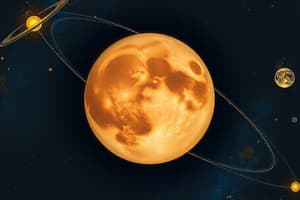Podcast
Questions and Answers
How long does it take for Venus to rotate once?
How long does it take for Venus to rotate once?
- 88 Earth days
- 59 Earth days
- 243 Earth days (correct)
- 224.7 Earth days
What is the primary gas that makes up Venus's suffocating atmosphere?
What is the primary gas that makes up Venus's suffocating atmosphere?
- Nitrogen
- Oxygen
- Hydrogen
- Carbon dioxide (correct)
Compared to most other planets, how does Venus spin on its axis?
Compared to most other planets, how does Venus spin on its axis?
- Clockwise (correct)
- Rapidly
- Stationary
- Counterclockwise
What is the average distance of Venus from the Sun?
What is the average distance of Venus from the Sun?
What is the surface temperature range of Venus?
What is the surface temperature range of Venus?
Which planet has similar characteristics to Earth but has a suffocating atmosphere with sulfuric acid clouds?
Which planet has similar characteristics to Earth but has a suffocating atmosphere with sulfuric acid clouds?
What is the most likely reason why Mercury is hard to see in the sky?
What is the most likely reason why Mercury is hard to see in the sky?
Why is Mercury denser than most planets, except Earth?
Why is Mercury denser than most planets, except Earth?
What makes Mercury's magnetic field weaker compared to Earth's?
What makes Mercury's magnetic field weaker compared to Earth's?
How does Mercury's surface compare to the Moon's?
How does Mercury's surface compare to the Moon's?
Which of the following statements accurately describes Venus compared to Earth?
Which of the following statements accurately describes Venus compared to Earth?
How many times could Mercury fit into Earth based on their respective sizes?
How many times could Mercury fit into Earth based on their respective sizes?
What is the reason why Venus doesn't appear to have many impact craters?
What is the reason why Venus doesn't appear to have many impact craters?
Which feature is NOT mentioned as observable on the surface of Venus?
Which feature is NOT mentioned as observable on the surface of Venus?
What distinguishes Aphrodite Terra on Venus?
What distinguishes Aphrodite Terra on Venus?
Why have all the earlier probes sent to Venus been destroyed?
Why have all the earlier probes sent to Venus been destroyed?
Which of the following is true about Venus's volcanoes?
Which of the following is true about Venus's volcanoes?
Why might Venus have fewer impact craters compared to other planets?
Why might Venus have fewer impact craters compared to other planets?
Flashcards are hidden until you start studying
Study Notes
Mercury
- Mercury is the smallest planet in our solar system.
- It is the closest planet to the Sun, making it difficult to see except at sunrise or sunset.
- Mercury has no moons and is too small to maintain an atmosphere.
- It is denser than any planet except Earth, with a large iron and nickel core covered by a rocky mantle and crust.
- Mercury's iron core produces a magnetic field that is 100 times weaker than Earth's.
- The planet is covered with craters, including the giant Caloris Basin, which is about 800 miles (1,300 km) across.
- The Caloris Basin's floor shows ridges and fractures, with mountains around the edge.
Venus
- As our closest neighbor, Venus is an obvious place to send space probes.
- The first successful landing on Venus was in 1970, and orbiters have used radar to peer through the thick cloud and reveal the surface since 1978.
- Venus has at least 1,600 volcanoes, with the tallest being Maat Mons, about 3 miles (5 km) high.
- The planet's highlands and lowlands include Aphrodite Terra, a highland region that runs two-thirds of the way around Venus.
- Venus has few impact craters, possibly due to meteorites burning up in the thick atmosphere or the surface being too young to have had many collisions.
- Most of the craters on Venus are less than 500 million years old.
Planet Profile: Venus
- Average distance from the Sun: 58 million km
- Surface temperature: -180°C to 430°C
- Diameter: 4,875 km
- Length of day: 59 Earth days
- Length of year: 88 Earth days
- Number of moons: 0
- Gravity at the surface (Earth = 1): 0.38
- Size comparison: Venus is similar in size, mass, and composition to Earth, but has no water or life and is covered with a thick atmosphere.
Key Features of Venus
- Venus has a thick, suffocating atmosphere composed of sulfuric acid and carbon dioxide gas.
- The atmosphere traps the Sun's heat, making it extremely hot.
- The surface of Venus is hidden by a dense layer of pale yellow clouds made of sulfur and sulfuric acid.
- Winds move the clouds around the planet from east to west at about 220 mph (350 km/h).
- Venus spins very slowly clockwise, taking 243 Earth days to rotate once, making its day longer than its year.
Studying That Suits You
Use AI to generate personalized quizzes and flashcards to suit your learning preferences.




